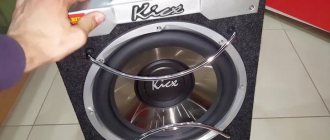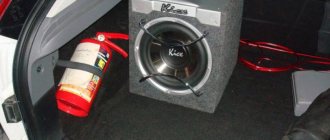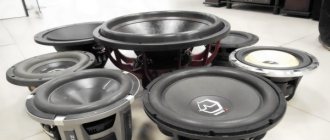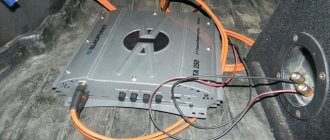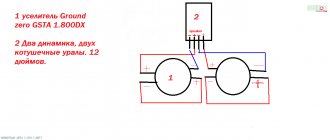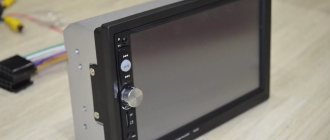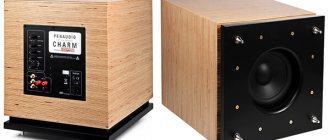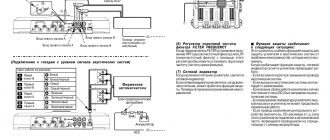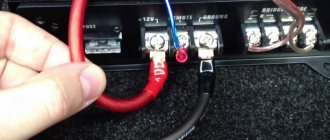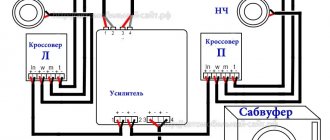A good subwoofer in a car will allow you to get a mobile music center or even create a kind of car cinema with deep sound. This forces motorists to supplement the standard acoustics with a woofer speaker. If a user wants to install a subwoofer without contacting a service, he should take into account some features of this process.
Types of subwoofers
Car woofers equipped with a custom housing can have a built-in amplifier or are connected directly to the car radio.
The use of an additional amplifier allows you to relieve the head unit. To perform adjustments across frequency ranges and match the signal with other acoustic devices, a separate crossover is placed. The subwoofer volume is adjusted using a separate rotary potentiometer mounted on the body of the product. The design has a special bass reflex, which provides expansion of the frequency range due to the resonance effect. There are designs of low-frequency devices in which the loudspeaker is placed on a dividing partition inside the housing.
The passive subwoofer is connected through the rear speaker connectors or to special plugs located on the head unit. Such a switching scheme increases the load on the electronics of the radio and negatively affects the operation of the components of the car's acoustic system. But since equipment without an amplifier has a low price, car owners are interested in the question of whether it is possible to connect a subwoofer while minimizing loss of sound quality.
Terminology:
The subwoofer formula is that the larger the area, and therefore the size of the diffuser, the more powerful and organic the bass.
The dimensions of the subwoofer are quite large. Basically, the subwoofer body is cubic in shape and made of standard materials for acoustics, for example MDF board made from wood fiber chips, made at high pressure and temperature. You can also find cylindrical and spherical systems, but they are not widely used. The low-frequency diffuser is located inside the subwoofer housing, and it is worth noting that the stroke of the speaker emitter can reach up to 7 centimeters! Subwoofers are divided into active and passive. The active ones already have an amplifier with them, and the passive one needs to be connected to a separate sound amplifier, the function of which is to amplify and transmit the signal to your Hi-Fi equipment (acoustic speakers, home theater speakers).
The main thing is your perception of the music and your feelings. Rely on them, and the chosen acoustics will delight you every time you listen. With the right choice, even inexpensive components can achieve maximum quality; all that is needed is a balance between them.
What you will need
How to connect a radio
To install a passive subwoofer without an amplifier on your own you will need:
- speaker cables required for switching;
- plastic buffers to hold the woofer housing in the luggage compartment of the car;
- plastic screwdriver for removing plastic interior trim;
- side cutters for cutting cables;
- plugs needed for connection;
- PVC tape or protective tube;
- flexible clamps;
- protective corrugated tube for laying cables.
Before starting installation work, you should make sure that the purchased equipment is compatible. Connecting speakers with inappropriate coil resistance causes the radio amplifier to overload, which damages the device. If the player has a security code, you need to make sure it is there. Otherwise, after connecting the battery to the on-board network, it will not be possible to restore the radio’s functionality.
Music for setup and testing
Regardless of what style of music will most often be listened to through the car's audio system, the subwoofer must be configured optimally for all areas that are characterized by a low frequency spectrum. It is divided into two types of low frequencies:
- useful lows - add richness;
- Parasitic lows are not perceptible to the human ear, but are felt on a physical level in the form of mild discomfort.
The setting involves precisely getting rid of or reducing parasitic lows, the frequency of which is from 30 to 40 Hz. They are mainly used in electronic music compositions and are a characteristic feature that should not be removed. Therefore, it is not advisable to use electronic music for tuning. The optimal material for testing would be to use compositions with classical instruments. This will allow you to compare the sound of familiar instruments and determine spurious sound frequencies, since bass lower than 30 Hz is rarely found in classical music.
There are also special programs for tuning speaker systems, tone generators that help configure a car subwoofer as accurately as possible by playing sound in a user-specified frequency range.
Assembly and connection
How to connect a standard and non-standard radio in a car
There are several types of subwoofers, and each of them can be assembled with your own hands, installed yourself, or, of course, you can buy a ready-made one. There is nothing complicated in self-assembly and you can ultimately achieve good results by solving an interesting problem and using extra parts lying around. It is much easier, of course, to buy a ready-made one and connect it without outside help. Connecting yourself will help you save a significant amount. Connecting a subwoofer carries the risk of damaging the interior trim. The car may be damaged. There are no more risks. The wires must be hidden. In general, wires come in different colors, but in any case they will be noticeable.
Flaws
The main downside of the Supra is that it is very difficult to tune. This is a problem not only for this unit, but for all subwoofers. In this case, there are 3 options left:
- Take it to a service center and competent specialists will calibrate the sound of your subwoofer for you;
- It takes several days to carry it out on your own, and you can adjust the sound yourself without special equipment.
In addition, the reasons for poor performance may be hidden due to trivial things:
- Perhaps the subwoofer does not have enough power supply, which affects its unstable operation. It is necessary to reconsider all the wiring and all soldering;
- Incorrect placement of the unit itself inside your car. Try moving it and then compare the sound before and after.
Car subwoofer supra srd 251a, active
In any case, an active car subwoofer is worth buying. It has much more advantages than disadvantages. This is a good gift for an experienced car enthusiast. Quality and reliability are guaranteed by the manufacturer. If your car is not only a vehicle, but also a piece of life, then, without a doubt, it should be filled with colors and bright sounds. Video review and photo materials will provide detailed information about the Supra active subwoofers, the price of which is not as high as it seems. The step-by-step instructions included in the kit will help you make the connection.
Selection of cables and wires
Which subwoofer for a car is better, active or passive?
The wires for the speaker system in the car are multi-core cables that transmit sound signals from the head unit or amplifier to the subwoofer. They play no less important role than the equipment itself. However, choosing the right option is not always easy. The cables presented in specialized stores differ in cross-section, core material, insulation and cost.
According to their purpose, cables for car audio come in 2 types:
- acoustic (such products are required to transmit a signal from the amplifier to the speakers);
- interconnect (they are needed to transport low-voltage signals from the radio to the amplifier).
The first piece of advice that professionals recommend following concerns the price category of the product. Thus, a cheap cable for connecting a subwoofer should not be purchased for expensive equipment, since the quality of the reproduced sound will deteriorate. At the same time, buying expensive wires for budget acoustics will be a waste of money.
Depending on the core material, wire sets come in several types:
- Copper. They, in turn, are divided into those made of rough copper and oxygen-free copper (OFC). In the first case, the products are basic and have a relatively low price. The base made of oxygen-free copper allows you to increase the conductivity of the cable, but the cost of the product will be an order of magnitude higher. Another copper wire is PCOCC, in which the base is made of pure copper.
- Copper-plated aluminum. This is another inexpensive wire option. Among the list of disadvantages of such a product, professionals name increased fragility and brittleness.
- Silver plated or silver. Such products for connecting a subwoofer to a receiver have high performance and durability, but are much more expensive.
Benefits of an active sub
- It improves bass sound quality and creates an immersive experience when listening to music.
Note: in order not to bother yourself with buying a subwoofer and selecting an amplifier for it, it is better to immediately buy an active subwoofer.
- A low-frequency amplifier is built inside the subwoofer housing. The device allows you to adjust the bass level and volume.
How to connect an active subwoofer to an amplifier
- Connecting and installing an active subwoofer is quite simple, given that it has all the outputs, jacks and outputs, as well as the necessary cables. This is an almost ready-made system of compact dimensions.
- Another advantage of active subs is the low amount of energy consumed, since over the past few years they have been using economical Class D pulse receivers.
- But built-in amplifiers rarely have high power, so if the bass quality is poor, then using a subwoofer requires an additional amplifier, which slightly increases the dynamic range of the acoustics.
How to connect an active subwoofer to an amplifier
Note: in this case, it is better to purchase a passive subwoofer and an amplifier separately. Moreover, such a purchase will cost much less.
Wires for subwoofer
The positive power wire is laid from the battery terminal and connected through a fuse.
You can draw the negative power wire from any metal bolt that is screwed to the car body. The recommended cross-section for the positive power wire is about six to eight square millimeters. Such a large cable diameter is explained by the high current consumption. Do not forget about the need to use a fuse that will protect the circuit from overload and short circuit. This fuse should be installed under the hood as close to the battery as possible. The second negative power wire, also called the ground wire, is screwed to the body at any convenient point. As a rule, its connection is made directly next to the installed subwoofer. This power wire is connected to the (-) terminal or to the terminal marked GND.
If your standard radio has separate connectors necessary for connecting an active type of subwoofer, then such switching is carried out without any difficulties. From the radio it is necessary to lay a coaxial shielded signal cable, which has corresponding connectors for connecting a subwoofer. On one side, this cable is connected to the radio in the SubOut connector, and in the subwoofer it is connected to the LFE or LineIn connector.
In cases where there is no corresponding output on the radio, you need to use an additional converter that allows you to transform the signal. The converter is connected to the output of the main speaker system.
This will allow us to obtain a linear standard signal at the output of the converter. Subsequently, such a linear signal is supplied to the corresponding subwoofer outputs. The connection is made using the same signal wires as in the first case if there is a subwoofer output.
To ensure the required sound quality, signal and cable products must be selected from professional manufacturers. The choice in specialized stores is extremely wide. We can recommend that you use cables from the following manufacturers - Profigold, Kimber Cable, Ost, Monster Cable. But what we wouldn’t recommend you do is buy a cheap Chinese cable.
It is quite possible that the cost of such a cable will seem attractive to you, but its quality is at a mediocre level, and you will not receive any return from the installed subwoofer. When performing installation work, the following rules must be observed. The cable is laid using the shortest route. Avoid sharp bends in the cable. When passing the cable through metal elements, rubber bushings should be used to protect the cable from chafing by metal.
These installation instructions will allow you to do all the work yourself and will significantly improve the sound quality of the standard stereo system in your car.
Examples of circuits for connecting active and passive subwoofers
Please note that not all car radios have LV. As a rule, factory models do not have this connector.
In such cases, it is recommended to additionally purchase a special adapter to connect a passive subwoofer, which connects to a radio that does not have a LP. In turn, the subwoofer will be connected to this adapter. How to do this correctly is shown in the diagram below.
Active connection diagram. subwoofer to a car radio without a LV channel via an adapter.
Passive connection diagram. SBV through an amplifier.
How to connect a subwoofer to an amplifier
Single channel connection
Connecting a subwoofer to an amplifier is not difficult; just connect the amplifier's audio output jack to the subwoofer coil or coils using speaker wires.
The wires should not be thin. In most cases, choose copper wiring with a cross-section of 4 mm and there will be no problems.
Connecting speaker wires
This subwoofer connection diagram is suitable for one channel of an amplifier or monoblock.
Connecting to a subwoofer via terminal block
Connecting to a subwoofer directly
Connecting a subwoofer with a bridge
In the case of using a multi-channel amplifier, the sub can be connected to two channels simultaneously, using the minus of one and the plus of the other, this connection is called bridged, with this method the power output by the amplifier increases significantly (see the specifications for specific numbers).
So you can connect a subwoofer to a two or four channel amplifier, using 2 channels for acoustics, and the remaining 2 for the subwoofer.
To connect a subwoofer with a bridge, make sure that your amplifier supports this feature.
If you connect a low-frequency speaker to an amplifier by changing the polarity, that is, connect the plus of the subwoofer to the minus of the amplifier output and vice versa, then the speaker will work in antiphase, there is nothing wrong with that, sometimes such a connection is used intentionally if the amplifier does not have phase adjustment (more about adjustment phases).
Connecting the subwoofer coils
The technical documentation for the subwoofer states the resistance of its coils (1 Ohm, 2 Ohm, 4 Ohm, rarely 0.5 Ohm), and the technical documentation for the amplifier indicates what resistance it can work with, this information is needed so that you connect correctly and effectively subwoofer to amplifier. The lower the resistance of the sub, the more power the amplifier will produce, provided that it can operate at this resistance. A subwoofer speaker may have several coils (1 or 2, rarely 4).
When the coils are connected in series, the resistance increases, while in parallel it decreases. If you don't want to learn definitions and count fractions, just save this cheat sheet (parallel and serial connections).
Connection options
How much ohm to connect the subwoofer
The higher the resistance, the better the sound quality; the lower, the more power the amplifier delivers. If you need a lot of loud bass, then turn it to the minimum that the amplifier can provide, and if the overall sound quality of the system comes first, then it is 2 Ohms or 4 Ohms, depending on the power output.
Video on how to connect 2 subwoofers or more. Subwoofer connection diagram 2x2 Ohm, 4x4 Ohm, 1x1 Ohm. Serial connection of speakers. Parallel connection of speakers. Basic principles.
Happy connections!
Basic principles when choosing a subwoofer
Many believe that a system with a low-frequency head located in a separate housing, which reproduces sound together with small satellites, is a subwoofer. This is wrong. The meaning of the term “subwoofer” is “below the woofer head”. A subwoofer is a separate acoustic system for reproducing the lower frequencies of the audio range, reducing the lower limit frequency to 20 Hz and below.
The main types of subwoofers: a) active; b) passive. The first type includes models equipped with a built-in amplifier. Their advantage is the unloading of the main home theater amplifier. In this case, the subwoofer requires additional power. The second type includes models that need to be connected to an external amplifier. There are several options for connecting a passive subwoofer. When the receiver supplies a signal to the main speakers and the subwoofer at the same time, the wideband output signal is transmitted to the subwoofer input. In this case, an additional separation filter (crossover) is used, which separates high and low frequencies and delivers filtered signals to the destination (low-frequency to the subwoofer, high- and mid-frequency to the main satellites).
A passive subwoofer has a number of disadvantages, as a result of which their cost is lower than that of active ones. A serious drawback is the need to accurately match the subwoofer with the existing speaker system. This is a very complex process. Connecting a subwoofer using a separate power amplifier and an electronic crossover filter will reduce nonlinear distortion due to the fact that the signal is divided according to a special circuit. And besides, the main amplifier is freed from increased load.
Recently, almost all active subwoofers have the ability to adjust the crossover frequency, so when using this subwoofer connection model, the procedure for matching the main components of the system becomes much simpler. As a disadvantage, we can note the rather high cost of active subwoofers. Despite this, when choosing, I advise you to take a closer look at active ones that have an internal amplifier. If you don't want to spend a lot of money on a subwoofer, take a look at Yamaha's budget models.
Instructions for connecting the Mystery passive subwoofer to the Pioneer radio
The schematic diagram of low-frequency speakers of both active and passive types is almost the same, with the exception of small additions related to non-active subwoofers.
For this reason, we will analyze the general method and then make changes.
The process of turning on a car radio with a passive subwoofer is very simple: it is connected directly to the amplifier, which, in turn, is connected in series to the car player.
The role of the standard amplifier in this circuit is to transmit the signal received from the sound of the playback device (car radio) to speakers with high and low resolution frequencies. Where the subwoofer itself acts as a converter of low-frequency signals, and its satellites act as a converter of high-frequency signals.
Due to its rather large dimensions, the installation of the subwoofer is carried out mainly in the luggage compartment of the car and the power supply wires have to be pulled through the entire cabin to the battery. Which does not improve its (interior) appearance.
Not active subwoofer
You can connect a passive subwoofer to a radio without an amplifier in 4 steps.
- Through the technological hole in the engine compartment we stretch the supply wire to the battery. We install a fuse on the positive (plus) wire closer to the battery.
- We pull the wiring into the cabin and stretch it to the trunk, if possible disguising it under the interior trim parts.
- We insert the wires through the finished technical hole (if necessary, we make it ourselves) into the trunk of the car. And we connect directly to the low-frequency speaker, according to the diagram (on, to -).
Connecting the subwoofer to the Pioneer radio via a single-core power (blue) wire and a wire with tulip connectors
Methods for installing a subwoofer in a car
There are several ways to install a woofer. More often the subwoofer is installed in the trunk of a car. It is attached to the back of the seat or installed in the center of the trunk itself.
Speakers without enclosures can be built into a vehicle's interior trim, trunk floor, or enclosure specifically designed for a specific vehicle. This approach helps save a lot of free space.
There are compact subwoofers on the market that are installed under the front seats of a car. But more often such devices cannot boast of power.
Where to install
For some motorists, installing acoustic equipment can be a big problem. The matter concerns both the size of the device itself and the car model.
Hatchback and minivan. In cars with this type of body, you can easily find space even to accommodate a large system. This is explained by the good trunk capacity.
Sedans. The trunk in sedans has a smaller volume, so there is not always room there to install a subwoofer. The problem can be solved by installing speakers in the armrests or on the rear shelf.
Cabriolet. In such a body, it is most difficult to connect a subwoofer to the car, since space is at a premium here. In this case, it is better to choose bandpass type acoustics or FC cabinets equipped with a bass reflex.
Instructions and manual for Supra BLUE DRAGON SBD-A4240 in Russian
11 pages of detailed instructions and user manuals
The SUPRA amplifier is being repaired again
SUPRA SBD A-4240 Review+test
SUPRA SBD-A2130 REVIEW - TEST AND POWER CHECK.
Car amplifier SUPRA SBD-A4270 goes into protection, repair, diagnostics, resoldering of transistors
Repair of SUPRA SBD-A4120, replacement of burnt mosfets
Auto-Amplifier Test
supra amplifier repair
Repair of SUPRA SBD-A4270, faulty power-on indication.
Types of subwoofers
DIY subwoofer installation diagram
First, a little about the product itself. A subwoofer is a speaker that produces low-frequency sound (bass). There are two types:
- Passive;
- Active;
Sub in the case
In the first case, the design consists of 1-3 speakers installed in a wooden case. Many people are interested in how to make a passive subwoofer? - very simple. To do this, you only need a pair of low-frequency speakers, for which the housing should be made of wood. The disadvantage of this product is that its power is high and for normal operation it will require the installation of an amplifier. Will the subwoofer work without an amplifier? - of course, this is an ordinary speaker, but its sound will leave the best (you won’t be able to get loud and clear bass with this connection).
subwoofer without housing
Active subwoofers differ in that they already have an integrated amplifier and can be directly connected to the radio.
Some radios may also have amplifiers in their design, which allows you to connect woofers directly, without additional equipment. But before you connect it to a standard radio, you should make sure that the parameters of its amplifier are higher than those of the subwoofer.
Required tools and materials
To successfully connect a subwoofer with your own hands, prepare the following tools and materials:
- wire cutters;
- knife;
- set of open-end wrenches;
- insulating tape;
- pliers;
- plastic ties;
- power cable;
- speaker cables;
- 60A fuse in the housing;
- plastic pullers for dismantling trim elements.
The length of the wire for powering the subwoofer and speaker cable depends on the specific car model and the possibility of laying the wiring under the trim. The cross-section of the power cable depends on the power of the active subwoofer or amplifier. For example, the power of a subwoofer is 200 watts, divided by 12 (the voltage in the electrical circuit of the car), we get 16.7 amperes. The power cable must withstand this current and not overheat. Based on this, the wire cross-section is selected.
How to setup
Correctly setting up the subwoofer allows you to make the most of all the capabilities of the speaker system in your car. Some music lovers still use factory settings, but this can greatly affect the sound quality. This feature is explained by the fact that the manufacturer cannot take into account the preferences of each listener. In addition, the quality of the reproduced sounds is greatly influenced by the type of car body and the installation features of the subwoofer.
Inaccuracies when connecting the subwoofer to the standard radio and setting up the system cause resonance in the car and rattling of individual elements of the plastic trim. To correct the sound, experts suggest using a specialized disc. It can be found in auto stores. This disc contains musical compositions with which you can fine-tune the settings.
Active subwoofer
To properly set up an active subwoofer in a car, you need to go through several stages of work. The stages of work are similar for any type of connection (to a monoblock or through amplifiers).
First of all, turn on the low-pass filter. It can be located on the radio itself or on the amplifier. The filter can be called as follows: Low Pass Filter (abbreviated LPF), as well as LF or low-pass filter. This action is necessary to minimize the sound of mid and high frequencies. When the filter is turned on, only bass will be heard.
Initial volume and frequency settings. Before you properly configure the sub, you need to find the filter frequency control - it is located on the amplifier and marked Frequency. Its indicator should be at around 80 Hz. The sensitivity control can be recognized by the inscription Gain or Level. Its level must correspond to that of other regulators.
Switching polarity. Only the fact in which direction the speaker cone will begin to move depends on the specific connection. In order to adjust the parameter, you need music in which the bass is reproduced clearly and clearly. After this, you need to find a sound option in which the subwoofer will produce sounds that are indistinguishable from the sounds from other elements of the speaker system.
The next task is to adjust the subsonic. This name refers to a subtonal filter that cleans musical compositions from excessively low sounds. In most cases, a level of 20 Hz will be sufficient. Those who prefer the loudest bass possible may need a level of 40 Hz.
It is equally important to configure the subwoofer taking into account mid-bass performance. This again requires volume control and a low-pass filter.
If you need soft bass, set the volume higher and the filter lower.
Passive subwoofer
Some buyers think about adjusting the radio for the subwoofer at the stage of choosing a speaker system. At the same time, there is an opinion that an active subwoofer is simpler and more convenient to operate, install and configure. This is not entirely true.
The advantage of active devices is simple, quick installation. Meanwhile, the absence of a separate amplifier for the subwoofer in the car reduces possible adjustment modifications.
Ready-made factory kits somewhat limit the buyer’s choice. You won’t be able to buy a powerful, high-quality product for relatively low prices. Well-equipped devices require large investments. To purchase an active subwoofer for a car, in some cases you will have to make concessions on certain parameters.
The highest quality and most flexible connection settings are those devices that were made to order. In these cases, you can make a parallel-connected subwoofer and make the most fine-tuning of the radio, subwoofer and other individual components of the system.
Problems you may encounter when connecting
The following difficulties may occur when connecting the device:
- A factory car radio usually does not have a special audio connector for an amplifier - this can be solved by purchasing a special adapter;
- Setting and correlation of low and high frequencies with the main acoustics of the car.
Please note: to properly connect the subwoofer to the car radio, you must have basic knowledge of electrical engineering. Otherwise, it is better to contact a car service center for specialist help.
CORRECTLY CONNECTING A SUBWOOFER TO AN AMPLIFIER
The subwoofer is connected to the amplifier using a car audio converter (adapter, adapter). This is a small device with a pair of RCA outputs and two pairs of wires, two of which are used to connect a dynamic emitter. The rest of the wires can simply be hidden - they are not needed for now. The line output wires (RCA OUT) must be connected to the amplifier.
The principle of connecting a subwoofer to a single-channel amplifier
To connect a car subwoofer to a mono amplifier, you will need to connect the positive and negative voltage wires from the amplifier to the same terminals of the subwoofer - that's all. Connecting several passive subwoofers is a little more complicated. Their connection is carried out in a parallel or series circuit, but with the obligatory precise calculation of their internal resistance.
The principle of connecting a subwoofer to a two-channel amplifier
In this option, the connection is made using a bridge circuit. This connection technology works great with virtually all two-channel amplifiers, to which you need to add another subwoofer. Here, too, everything is simple - we take the positive wire from one channel, and the negative wire from the 2nd channel and feed it to the corresponding terminals of the subwoofer.
When making this connection, special attention should be paid to the internal resistance of the subwoofer, which should be 4 ohms. In addition, you should take into account that with this option, the output power of both channels is added
If the amplifier has the function of switching mono and stereo modes, then in this case the wires are connected to the positive and negative terminals of one channel. If there is a need to connect two subwoofers to the amplifier, then the speaker cable from them is fed to different channels.
For correct and clear operation of the subwoofer, you should provide an LPF low-pass filter, which will set the upper limit of the low frequency.
The principle of connecting a subwoofer to a four-channel amplifier
The standard connection of a speaker system to a four-channel amplifier is considered to be a scheme with two speakers and one subwoofer.
So, the typical way to connect an audio system to an amplifier would be the option of two speakers and a subwoofer. In this case, the sub is connected to the amplifier via a bridge circuit, and the audio speakers are each connected to their own channel. The peculiarity of this connection is that the speakers must work with the front channels, and the sub with the rear ones. But at the same time, it is possible to connect a pair of subwoofers to different rear channels.
pros
Active subwoofer supra srd 301a
Let's note the main advantages of the Supra active car subwoofer:
- The rated power of the unit is 180 W of exquisite bass;
- Excellent, strong and very reliable case;
- The operating range of the single speaker is 28 Hz – 250 Hz;
- The diagonal of the speaker is 200-300 mm, which is enough for a salon of any size;
- High-quality and reliable bass amplifier – MOSFET;
- A price that will pleasantly surprise you;
- Very easy installation and connection.
You get this and much more with the Supra subwoofer. It must be said that there are much more positive reviews about this musical device than negative ones. More precisely, few people found any negative sides to the Supra at all. Every customer who purchased an active Supra car subwoofer was satisfied with its performance and reliability.
Ultimate power and endurance performance
Supra active subwoofer
There is no need to worry that the winding will burn out or the sound membrane will break while working at the limit. The subwoofer (see The best subwoofers of 2014 and their review) was designed for maximum loads and, therefore, it works even under unimaginable loads. The reason for this:
- Multi-level copper winding of the coil, which is much more productive than the cheap aluminum version: the current transfer capacity of copper conductors is almost 2 times higher than aluminum ones;
- Excellent compacted cellulose, which plays a major role in Supra, since it is this membrane paper that accelerates sound to such frequencies;
- The membrane itself is glued to the metal frame of the speaker with elastic glue, which allows the speaker to vibrate within its capabilities;
- The huge magnetic base makes it possible to modulate electromagnetic flows into high-quality and clear sound without dissipating power.
All these criteria guarantee the quality of the sound and the quality of the unit itself.
Frame
A few words should be said about the subwoofer housing itself:
- The length of the working area is calculated with maximum accuracy;
- The size of the Supra allows you to enjoy clear sound and if you think that such sound volume is not enough for such a powerful car, then you are wrong;
- If the Supra frame were a little larger, it would cause a hum inside the box, which, of course, you want to avoid.
Note. Also, the small body makes it possible to easily transport or move the sub from one car to a second.
Advantages of an active subwoofer
Active subwoofer supra
Let us emphasize that this subwoofer is active, which will allow you to use it outside of your car: at sea, in nature, on a hike. Even when the Supra starts to sound in an open space, the sound will still be high-quality and powerful. If you wanted to throw a disco in the evening in the yard, no problem, the active Supra car subwoofer is at your service, and the adjustable BassBoost will allow you to remove the bass and enjoy just good music. The Supra subwoofer is simply a universal device for all occasions. Buying this musical equipment will be a great addition to your favorite car.
Four main types
The main types of subwoofers are:
- open;
- hull;
- active;
- passive.
An open subwoofer is the first option. It needs to be built into any of the car panels. This is a smart option for anyone who doesn't like to fiddle around for too long. There is a second option - case-based. It will have to be built into a special box. The calculation here must be accurate. This box increases the sound pressure on the speaker. The speakers are 100% engaged. With its help you can slightly adjust the sound.
There is also a distinction between passive and active. Passive is simple. It lacks an amplifier and crossover. It must be connected in parallel with other speakers. You can make a crossover yourself and include it in the system. But it’s easier to immediately install an active subwoofer, which has both an amplifier and a crossover. Connecting an active subwoofer to your car will solve many problems at once.
In addition, a passive subwoofer sometimes causes a quieter sound from the speaker system, which must be taken into account when making a decision. Active will give good volume. An amplifier and crossover simplify the wiring diagram. It is easier to install an active subwoofer with your own hands without experience, although some may disagree with this point of view.
The amplifier and crossover are important elements. Think about the available options, compare them with the final goal, which is drawn in the mind - rationally. If there is no time or desire to choose or think, in the worst case, an extra part may appear in stock, which is also not a disaster. The supplier or seller, alas, is not obliged to accept back the purchased item if there is no receipt, damage appears, and so on. The money spent could have been invested in something else, but you can always sell speakers, microphones, subwoofers to someone who really needs them. This will allow you to return most of the amount.
Meet the Supra SRD 301A
Active car subwoofer supra srd 301a
First of all, it should be noted that this is a very compact and powerful subwoofer. It can be placed both in the car interior and in the trunk. In addition, there are other advantages:
- You can easily control the bass level remotely, which is very convenient and simply irreplaceable on the road;
- The Supra's active subwoofer features a single speaker rated at a whopping 180 watts, enough to rock your vehicle;
- The subwoofer body is made of low-carbon plastic, which makes it lightweight and, at the same time, very strong and reliable.
Note. The Supra also has a very stylish and pleasant-to-touch upholstery, which is why it will look great in the trunk. Such a strong sound on this subwoofer was achieved thanks to a powerful MOSFET amplifier, which produces not only impressive bass, but also excellent clear sound. It is also important that the cost of this unit will not hit your pockets hard, which is very important in our time.
- Supra is equipped with a single speaker, the diagonal of which ranges from 20 to 30 cm, depending on the model range.
Advice. Do not rush to throw this model aside just because it has one speaker. A monodynamic subwoofer is good because the vibration of the speaker does not cause resonance, which does not have a very good effect on the sound. The big plus of the Supra active speaker is that it operates at incredible frequencies, from 20 Hz to 250 Hz.
Connection instructions without amplifier
The location of the subwoofer depends on the car model and the design of the subwoofer. The equipment is placed in the luggage compartment and is kept from moving by stops attached to the floor covering. There are devices located under the front passenger seat. Flush-mounted subwoofers have reduced dimensions, allowing the device to be placed in a narrow cavity under the chair. During installation, it is necessary to take into account the location of the ventilation ducts and electrical cables of the standard seat heating system.
An acoustic double interconnect cable of the RCA standard is laid through the car interior along the standard electrical harnesses. To ensure protection of the cord, a corrugated sleeve is used, which is laid along the thresholds of the car. From above, the highway is covered with carpet floor covering and plastic cladding. At the ends of the cable it is necessary to install connectors intended for connection to the head unit and subwoofer.
A number of radios are equipped with a standard cable harness, which has a round connector for connecting a subwoofer. Since the equipment is connected via 2 plugs, it is necessary to use an additional splitter. The product is placed next to the speaker, an RCA cable is laid through the interior, but only 1 branch is used. The “tulips” at the end of the splitter are connected to the connectors of the low-frequency speaker.
To connect a passive subwoofer to the rear outputs of the radio, you should combine the outputs into a common circuit. Equipment with a power lower than the total output of the channels is connected to the rear speaker outputs. For example, Pioneer head players equipped with a 4-channel amplifier with a power of 50 W per stream allow the use of a woofer of no more than 70 W.
To ensure the functioning of the subwoofer, you must enable the required operating mode through the menu of the head unit. User can select normal or reverse phase mode. After selecting the required parameter, the settings are saved to the radio's memory. When you turn off the power or press the special reset button, the memory is cleared and the setting will need to be repeated again.
The cutoff frequency is separately regulated, which is selected from a range of values. The number of valid options depends on the modification of the player. To ensure rich sound, a high-pass filter is configured, which stops the transmission of the corresponding sounds through the standard front and rear speakers. Head units use a parameter for additional bass boost; the value is selected from a step range.
Since direct connection does not provide high quality sound reproduction, it is recommended to connect low-frequency speakers through an additional amplifier. The equipment is connected to the head unit with an additional signal cable, through which a switching pulse is sent. To power the amplifier, it is necessary to lay a separate line to the battery, providing it with a fuse installed in a special housing. It is prohibited to connect the amplifier to the side lighting or interior lighting circuits.
Manual
1. Line Input
This connector is intended for connection to a head unit with RCA outputs.
2.Adjusting the input signal Level
These controls are designed to adjust the amplifier's input level. For correct tuning, first move the control to the MIN position and the head unit volume control to 3/4 of the maximum (BASS and TREBLE controls at zero). Then slowly turn the Level knob towards the MAX position.
Note:
If the sound becomes distorted, stop, then turn the control back a little.
3. Bass Boost Filter
This filter is designed to cut both high and low frequencies at the same time. Set the filter controls to the desired position, and only the permitted frequency range will be passed to the amplifier output.
4. Low pass filter BASS FREQ
When connecting a subwoofer to an amplifier, set the crossover switch (5) to the LP position. Set the crossover frequency to 100 Hz or lower, otherwise the speakers may be damaged.
5. Crossover switch
Allows you to select the filtering mode for the signal fed to the speakers: LP (low-pass filter), HP (high-pass filter) and FLAT (filter off).
MANUAL
Fourth step: adjusting the acoustic phase
In order for the bass to sound in harmony with the other frequencies protruding from the front speakers and at the same time there is no perceived separation on the sides of the car, you need to correctly adjust the acoustic phase. This parameter is adjusted according to the driver’s personal feelings and is regulated by the Acoustic phase phase shifter, which is located on the front panel of the amplifier. You should gradually rotate the filter adjustment phase shifter clockwise until the front speakers and subwoofer begin to play in the same plane/acoustic phase (there will be no sensation of separate bass output from the rear). To check compositions, you need to listen to them in the driver's seat, where the sound separation is always more noticeable.
Watch the setup video:
Connecting the positive cable
Clean the ends of the power cable and install the terminals. The shape and size of the terminals are selected according to the shape of the connectors where you will connect them. And also take into account the cable cross-section.
The terminals are crimped. You can crimp with regular pliers. With the exception of special ones, which require the presence of pliers with jaws of a certain shape. But it’s hardly worth buying these for one-time use.
An example of connecting the power cable for a subwoofer to a battery
So, we placed the bare conductor in the terminal so that there were several millimeters of insulation in the grip. That is, when you crimp the terminal, the bare wire should not peek out from under the terminal. If you have a soldering iron, it is better to solder the wire to the pad and then crimp it. But the conditions are the same - bare wires do not stick out from under the terminal.
Selecting a fuse rating for connecting 12 V to a subwoofer (or amplifier)
Then, at a distance of 15–20 cm from the edge that you will connect to the battery, make a cut and install the fuse. Take a fuse for 12 V, and for the current that is supposed to pass. For an active subwoofer it is selected depending on the power, if not specified or not included.
We pull the cable into the cabin through the standard hole in the bulkhead. It must be protected with a plastic or rubber pad. We monitor its condition and the condition of the insulation of the wires that are already there. We pull the cable around the cabin so that it is unlikely to be damaged. It's best in the center of the cabin.
We fasten it with plastic clamps and fix it often, especially in places of turns. But it’s better to postpone fixing until you’ve also laid out the speaker wires. They will have to be pulled from the radio also to the amplifier or subwoofer.
Several connection features
If you connect a passive speaker, then you need to do this through an amplifier. It already has special inputs and outputs designed for connecting a low-frequency device.
Its connection also occurs through the use of an speaker cable.
Connecting an active subwoofer to speakers
Table for selecting wires for a subwoofer
The amplifier is connected directly to the radio using a cable with an RCA connector:
If it is not possible to purchase an additional amplifier, then you can do without it. In this case, the device will be connected directly to the front speakers. But you need to understand that in this case the sound quality will be much lower. At the same time, when connecting an active device, you can do everything the same, but the speaker system will sound good;
RCA cable
In order for sound to be filtered, a special filter can be installed at one specific connection point (see It’s not difficult to make a filter for a subwoofer yourself). Its location is usually indicated on the diagram.
Cable cross-section and proper selection
How to connect speakers to an active subwoofer
Subwoofer connection diagram
Before starting work, you should turn off the power to the car. To do this, you need to disconnect the negative terminal from the battery.
Only after this you can start working:
- First you need to decide where exactly the device will be located. After this, you will need to run a cable from the radio to it;
- The wires are laid under the interior trim. To facilitate work, there are special technical holes through which cables are routed.
Connecting an active subwoofer from the rear speakers
- The wire must be secured along its entire length. For this you can use special clamps. To prevent it from being visible in the future, the cable can be carefully disguised;
- In the place where the subwoofer will be installed, it is recommended to lay shock-absorbing material, which will protect the device from unnecessary vibrations;
- The amplifier should not be placed near the subwoofer as this may cause interference. It is desirable that it be located at some distance from it. In this case, both devices must be fixed with bolts;
- The cables must be inserted into the connectors provided for this purpose.
Connecting speakers
Diagram for connecting an active subwoofer to speakers
To connect speakers you may need the following materials and tools:
- Acoustic cable. It must be good, so you cannot skimp on it. It may determine what the sound produced by the speaker system will be;
- Corrugation;
- Material intended for sound insulation;
- Drill, tester.
The operation is performed in several main stages:
First you need to determine where exactly the purchased speakers will be located. Some cars already have standard seats, which is a big plus.
The rear speakers are installed on the trunk shelf. It is also recommended to create special podiums so that the devices can be held better
To do this, you need to dismantle the standard shelf, instead of which you should install a special acoustic shelf; Next you need to pay attention to the electrical wiring. If the doors do not have holes designed for it, you will have to drill them yourself
It should be taken into account that the cable must be pulled over a metal surface with special protection. If this is not done, a short circuit may occur; To make it easier to route the cable to the rear speakers, you can use the edges of the car. Cables must not be laid under rugs; The speaker cable must be insulated. To do this, you can use corrugated tape or electrical tape; After dismantling the interior trim, you need to tighten the cable inside using wire.
How to connect speakers to an active subwoofer
Thus, you can connect the speakers and subwoofer yourself. Moreover, the price of both devices depends on the manufacturer, as well as on some individual characteristics.
Before starting the process, it is recommended that you familiarize yourself with photos and videos on this topic. The instructions should also be useful.
Home theater connection
By home theater, users mean different sets of devices. This is either multi-channel acoustics or a set of TV, player and speakers. Next we will look at two options:
- How to use a PC as a source of sound and image by connecting a TV and speakers to it.
- How to directly connect existing cinema acoustics to a computer.
Option 1: PC, TV and speakers
In order to reproduce sound on speakers from a home theater, you will need an amplifier, which is usually a supplied DVD player. In some cases, this may be a module built into one of the speakers, for example, a subwoofer. The connection principle in both situations is identical.
Option 2: Direct speaker connection
This connection is possible if the amplifier and computer have the necessary connectors. Let's look at the principle of operation using the example of acoustics with 5.1 channels.
- First we need four adapters from 3.5 mm miniJack to RCA (see above).
- Next, we use these cables to connect the corresponding outputs on the PC and the inputs on the amplifier. To do this correctly, you need to determine the purpose of the connectors. In fact, everything is quite simple: the necessary information is written next to each slot.
- R and L (Right and Left) correspond to the stereo output on the PC, usually green.
- FR and FL (Front Right and Front Left) are connected to the black “Rear” jack.
- SR and SL (Side Right and Side Left) – to gray with the name “Side”.
- The center speakers and subwoofer (CEN and SUB or SW and CE) are connected to the orange connector.
If some sockets on your motherboard or sound card are missing, then some speakers will simply be unused. Most often, only a stereo output is available. In this case, the AUX inputs (R and L) are used.
It is worth keeping in mind that sometimes, when connecting all 5.1 speakers, the stereo input on the amplifier may not be used. It depends on the principle of its operation. Connector colors may differ from those shown above. Detailed information can be found in the instructions for the device or on the manufacturer’s official website.
Sound settings
After connecting the speaker system to your computer, you may need to configure it. This is done using the software included with the audio driver, or using standard operating system tools.
Read more: How to set up sound on your computer
Conclusion
The information provided in this article will allow you to use the equipment at hand for its intended purpose. The process of creating a symbiosis of a home theater with a computer is quite simple, you just need to have the necessary adapters available
Pay attention to the types of connectors on devices and adapters, and if you have difficulties determining their purpose, read the manuals
Describe what didn't work for you. Our specialists will try to answer as quickly as possible.
